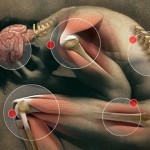PARKINSON’S DISEASE (PD)
 Parkinsonism is a clinical syndrome consisting of four cardinal features: bradykinesia (slowness and poverty of movement), muscular rigidity, resting tremor (which usually abates during voluntary movement), and an impairment of postural balance leading to disturbances of gait and falling. The most common cause of Parkinsonism is idiopathic PD, first described by James Parkinson in 1817 as paralysis agitans, or the “shaking palsy.” The pathological hallmark of PD is a loss of the pigmented, dopaminergic neurons of the substantia nigra pars compact, with the appearance of intracellular inclusions known as Lewy bodies.
Parkinsonism is a clinical syndrome consisting of four cardinal features: bradykinesia (slowness and poverty of movement), muscular rigidity, resting tremor (which usually abates during voluntary movement), and an impairment of postural balance leading to disturbances of gait and falling. The most common cause of Parkinsonism is idiopathic PD, first described by James Parkinson in 1817 as paralysis agitans, or the “shaking palsy.” The pathological hallmark of PD is a loss of the pigmented, dopaminergic neurons of the substantia nigra pars compact, with the appearance of intracellular inclusions known as Lewy bodies.
Progressive loss of dopamine-containing neurons is a feature of normal aging; however, most people do not lose the 70% to 80% of dopaminergic neurons required to cause symptomatic PD. Without treatment, PD progresses over 5 to 10 years to a rigid, a kinetic state in which patients are incapable of caring for themselves. Death frequently results from complications of immobility, including aspiration pneumonia or pulmonary embolism. The availability of effective pharmacological treatment has altered radically the prognosis of PD; in most cases, good functional mobility can be maintained for many years, and the life expectancy of adequately treated patients is increased substantially.
It is important to recognize that several disorders other than PD also may produce Parkinsonism, including some relatively rare neurodegenerative disorders, stroke, and intoxication with dopamine-receptor antagonists. Drugs in common clinical use that may cause Parkinsonism include antipsychotics such as haloperidol and Thorazine and antiemetics such as prochloperazine and metoclopramide. Although a complete discussion of the clinical diagnostic approach to Parkinsonism exceeds the scope of this chapter, the distinction between PD and other causes of Parkinsonism is important because Parkinsonism arising from other causes usually is refractory to all forms of treatment.
The primary deficit in PD is a loss of the neurons in the substantia nigra pars compact that provide dopaminergic innervation to the striatum (caudate and putamen). The current understanding of the pathophysiology of PD can be traced to neurochemical investigations that demonstrated a reduction in the striatal dopamine content in excess of 80%. This paralleled the loss of neurons from the substantia nigra, suggesting that replacement of dopamine could restore function. These fundamental observations led to an extensive investigative effort to understand the metabolism and actions of dopamine and to learn how a deficit in dopamine gives rise to the clinical features of PD. We now have a model of the function of the basal ganglia that, while incomplete, is still useful.
The actions of dopamine in the brain are mediated by a family of dopamine-receptor proteins. Two types of dopamine receptors were identified in the mammalian brain using pharmacological techniques: D1 receptors, which stimulate the synthesis of the intracellular second messenger cyclic AMP, and D2 receptors, which inhibit cyclic AMP synthesis as well as suppress Ca2+ currents and activate receptor-operated K+ currents. Application of molecular genetics to the study of dopamine receptors has revealed a more complex receptor situation than envisioned originally. At present, five distinct dopamine receptors are known. All the dopamine receptors are heptahelical G protein-coupled receptors (GPCRs).
The five dopamine receptors can be divided into two groups on the basis of their pharmacological and structural properties. The D1 and D5 proteins have a long intracellular carboxyl-terminal tail and are members of the class defined pharmacologically as D1; they stimulate the formation of cyclic AMP and phosphatidyl inositol hydrolysis. The D2, D3, and D4 receptors share a large third intracellular loop and are of the D2 class. They decrease cyclic AMP formation and modulate K+ and Ca2+ currents. Each of the five dopamine receptor proteins has a distinct anatomical pattern of expression in the brain. The D1 and D2 proteins are abundant in the striatum and are the most important receptor sites with regard to the causes and treatment of PD. The D4 and D5 proteins are largely extrastriatal, whereas D3 expression is low in the caudate and putamen but more abundant in the nucleus acumens and olfactory tubercle.
Considerable effort has been devoted to understanding how the loss of dopaminergic input to the neurons of the neostriatum gives rise to the clinical features of PD. The basal ganglia can be viewed as a modulatory side loop that regulates the flow of information from the cerebral cortex to the motor neurons of the spinal cord. The neostriatum is the principal input structure of the basal ganglia and receives excitatory glutamatergic input from many areas of the cortex. Most neurons within the striatum are projection neurons that innervate other basal ganglia structures. A small but important subgroup of striatal neurons consists of interneurons that connect neurons within the striatum but do not project beyond its borders. Acetylcholine and neuropeptides are used as transmitters by these striatal interneurons.
By: Ammarah Khan




Greetings from Idaho! I’m bored to tears at work so I decided to check out your blog on my iphone during lunch break. I really like the info you present here and can’t wait to take a look when I get home. I’m amazed at how quick your blog loaded on my phone .. I’m not even using WIFI, just 3G .. Anyways, awesome site!
Does your blog have a contact page? I’m having a tough time locating it but, I’d like to shoot you an e-mail. I’ve got some suggestions for your blog you might be interested in hearing. Either way, great blog and I look forward to seeing it grow over time.
Heya i’m for the first time here. I found this board and I to find It truly useful & it helped me out a lot. I’m hoping to offer one thing back and aid others like you helped me
Greetings! Very helpful advice on this article! It is the little changes that make the biggest changes. Thanks a lot for sharing!